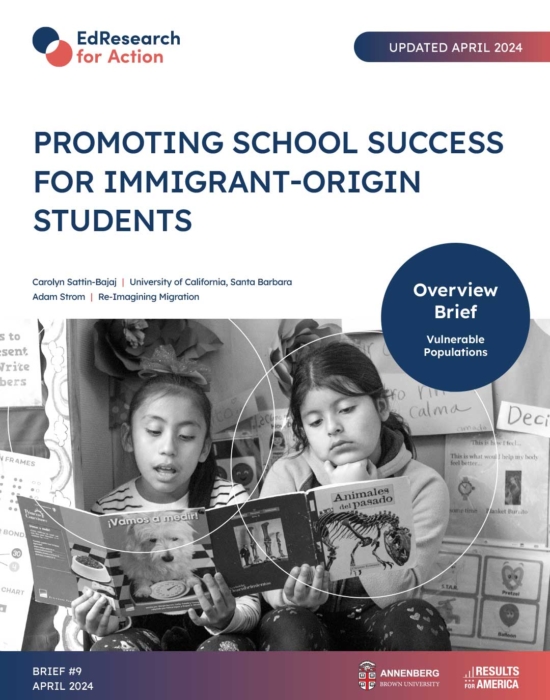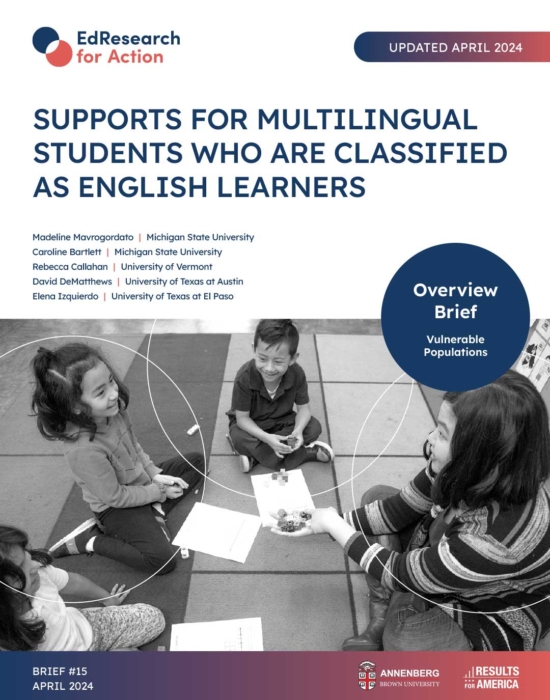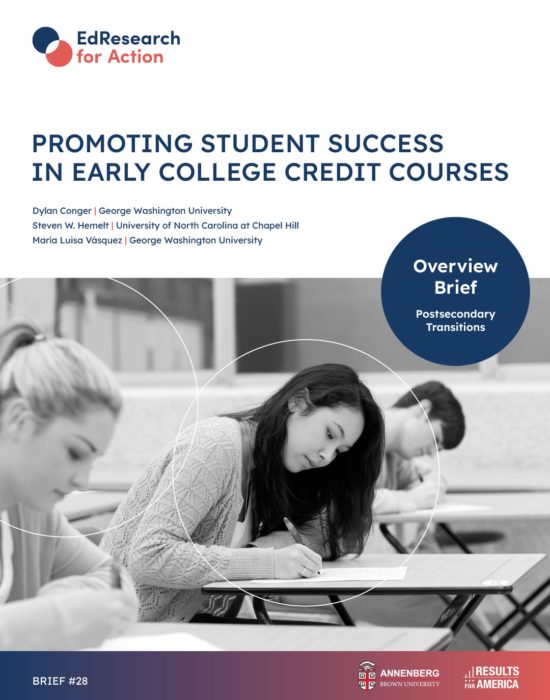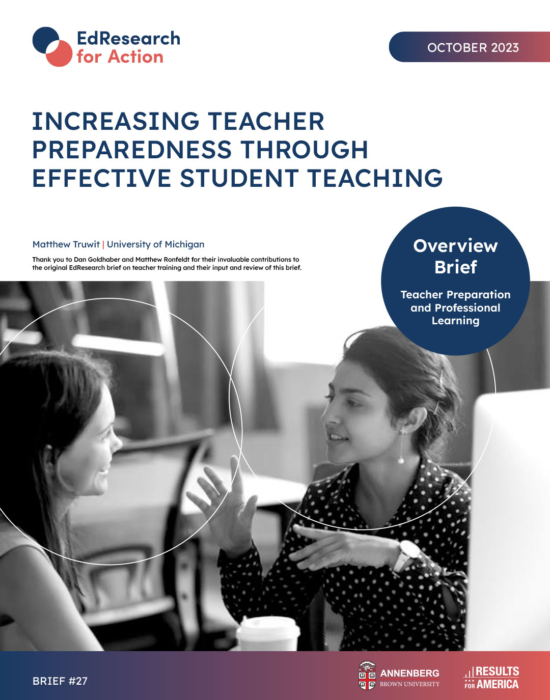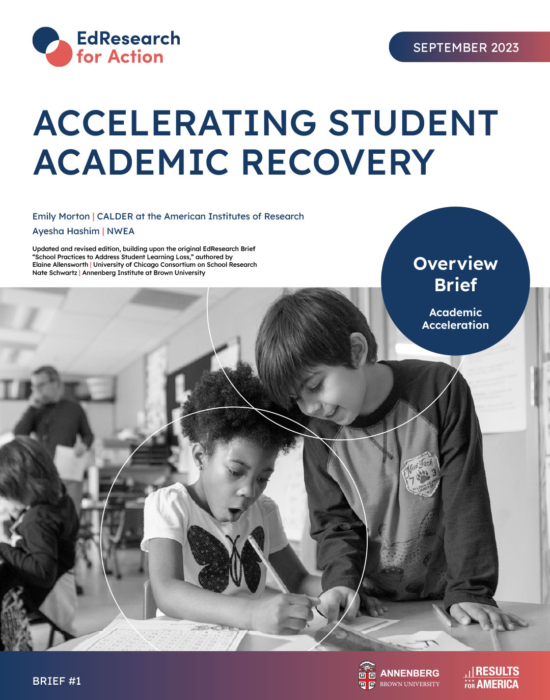TIER 1 INSTRUCTIONAL STRATEGIES TO IMPROVE K-4 READING COMPREHENSION
This brief is one in a series aimed at providing K-12 education decision makers and advocates with an evidence base to ground discussions about how to best serve students during and following the novel coronavirus pandemic.
James Kim | Harvard University
Zhongyu Wei | Harvard University
June, 2022 | Brief No. 25
Central Question
How can system leaders improve reading comprehension for students in kindergarten to grade 4 through stronger Tier I English language arts instruction?
Key Insights
Strategies to Consider: Curriculum Content
- English language arts curricula that integrate science and social studies content show strong promise in improving reading comprehension outcomes from kindergarten to grade 4.
- Schools that adopt curricula that simultaneously build word recognition and language comprehension skills can boost student reading outcomes, especially when instruction begins in early grades.
- Simple, low-cost changes to the texts that students read, such as using sets of texts that contain overlapping words and related concepts, can improve skills that support reading comprehension.
- When districts and schools allow teachers to select from structured adaptations to interventions and curricula, student reading comprehension improves relative to when teachers must strictly follow a specific protocol.
Strategies to Consider: Context & Supports
- Intentionally planning the sequence of English language arts curriculum and assessments from kindergarten to grade 4 to progress toward more complex subject matter while avoiding repetition supports stronger reading comprehension.
- Using formative assessments to flexibly group students by skill level has strong positive effects on students’ word recognition, vocabulary, and reading comprehension outcomes.
- Districts can amplify the effects of curriculum interventions by offering literacy coaching and sustained teacher professional development focused on translating reading research findings into classroom practice.
- Tutoring is an effective Tier 2 intervention for students who are struggling with Tier 1 core instruction and the impact of tutoring can be amplified when it is connected to Tier I classroom content.
Strategies to Avoid
- Reducing instruction time in science and social studies undermines efforts to improve reading comprehension outcomes for all learners.
- The oft-repeated phrase, “learning to read, then reading to learn,” diverts attention from the need to build systems and curricula that continuously develop young children’s language comprehension skills, particularly for historically marginalized students.
- A narrow focus on short-term solutions for improving grade 3 reading scores works against the broader goal of improving Tier I ELA instruction across a system.
Breaking Down the Issue
Throughout the early elementary grades, students struggle to comprehend grade-level texts that require strong word recognition skills, vocabulary and background knowledge, mastery of complex syntax, and the ability to draw inferences.
National Assessment of Educational Progress (NAEP) results showed that grade 4 reading scores dropped from 2015 to 2019, with larger drops for students at the lower end of the performance distribution and for English-learning and historically marginalized students.
- Low-performing fourth graders experience challenges reading words with speed and accuracy and reading connected text out loud with proper speed, accuracy, and expression.
- During the pandemic, reading performance further declined, with particularly large drops for students in younger grades, students from historically marginalized groups, and students attending high-poverty schools.
Young children particularly struggle to comprehend nonfiction texts that require background knowledge.
- Fewer than 5% of U.S. first and second graders can understand complex grade-level nonfiction texts with high knowledge demands.
- Over the past decade, U.S. 9-year-olds have made no gains in their ability to read nonfiction passages, and low-performing readers have fallen farther behind.
- The National Assessment of Educational Progress NAEP Long-Term has administered the same reading passages since 1982. Two-thirds of these passages are nonfiction, so it is a useful measure of trends in students’ nonfiction reading skills. While the performance of U.S. 9-year-olds has remained flat from 2012 to 2020, the performance of the very lowest-performing students (10th percentile) has declined.
Word recognition and language comprehension are central to how well a student understands a written passage.
The Simple View of Reading (SVR) is a commonly used framework for describing the critical skills involved in reading. The SVR defines reading comprehension as the product of word recognition and language comprehension, which work synergistically to support young children’s ability to read for understanding.
- Word recognition is the ability to read words accurately and with automaticity. Word recognition depends on phonological awareness (the ability to manipulate and attend to the specific sounds in words), decoding (the application of letter-sound knowledge in reading words), and sight recognition of familiar words.
- Language comprehension is the ability to understand spoken language. This ability includes receptive vocabulary (the ability to understand and recognize the meaning of words), morpho-syntactical skills (the knowledge of grammar at the word, sentence, and paragraph level), and discourse comprehension (the ability to understand meaningful discussions).
- Students primarily learn word recognition skills through direct teaching and repeated practice opportunities, whereas they learn language comprehension skills through a combination of direct teaching and experiences outside formal school instruction. For example, parents and caregivers can have conversations with children before, during, and after they read books together, using open-ended questions that build language skills and vocabulary from kindergarten to third grade.
Reading comprehension also depends on the reader, the text, the activity, and the context.
Many factors beyond readers’ skills at word recognition and language comprehension also affect their reading comprehension.
- Examples of these factors include student’s background knowledge, their knowledge of reading comprehension strategies, their interest in the subject, features of the text such as its wording and visual format, the activity at hand (e.g., skimming vs. studying), and the context (students’ identities and cultural backgrounds).
As students master word recognition skills around third or fourth grade, language comprehension abilities play an increasing role in building overall reading comprehension—yet educators often underemphasize activities that develop these abilities.
- A study of teachers of emergent bilinguals (i.e., students developing proficiency in English and another language) in grades K-2 used diary entries about daily literacy practices before and after COVID-19 to show that the frequency of language comprehension-focused activities (e.g., activities to support vocabulary learning, book discussions, extended writing) dropped more precipitously than the frequency of word recognition activities.
- A recent synthesis of 43 experimental and quasi-experimental evaluations of language comprehension interventions for K-5 students found that explicit instruction to support vocabulary, morpho-syntactical skills, and discourse comprehension improved reading comprehension outcomes. However, nearly two-thirds of the studies (n=29) focused on K to 2 students, underscoring the need for more evaluation of language comprehension interventions beyond second grade.
Failing to read proficiently in the early elementary grades can have long-lasting negative consequences for students’ future educational and economic success.
Students who do not learn to read proficiently by grade 3 experience reduced opportunities to learn vocabulary and general knowledge and difficulties in learning across content areas.
- These negative academic effects accumulate; one in six children who are not reading proficiently by third grade do not graduate from high school on time, a rate that is four times higher than for proficient readers.
Strategies to Consider: Curriculum Content
English language arts curricula that integrate science and social studies content show strong promise in improving reading comprehension outcomes from kindergarten to grade 4.
Content-rich curricula typically include science and/or social studies content related to a theme, such as human body systems or space exploration.
- Activities often include direct instruction in reading, writing, and the social studies or science content area of focus; teacher read-alouds of intentionally sequenced, complex texts about the content; vocabulary-building activities; supported independent reading and writing practice related to the content; and science inquiry.
- Two randomized controlled trials have demonstrated that the Core Knowledge Language Arts: Knowledge curriculum, improves kindergartners’ vocabulary (a 4.3-month gain), science knowledge, and social studies knowledge for kindergartners, relative to business-as-usual literacy instruction.
- A randomized controlled trial of Zoology One shows positive effects on kindergartners’ reading comprehension (a 1.3-month gain), letter-naming fluency, and motivation, at a cost of approximately $480 per student, relative to business-as-usual literacy instruction. Teachers spent similar time on science instruction for both treatment and control groups. The researchers found no evidence of impact on decoding skills or writing.
- A longitudinal randomized controlled trial involving 30 schools and nearly 3,000 first and second graders shows that the Model of Reading Engagement (MORE) improved students’ ability to read complex science passages after two years of implementation. Students who participated in grade 1 thematic content literacy lessons in science and social studies followed by wide reading of thematically related informational texts during summer, and grade 2 thematic content literacy lessons in science that built upon and extended related topics in grade 1, demonstrated approximately 2.8 months of gain in reading.
Social studies curricula focused on close analysis of text structure instruction (CATS) and project- based learning have also demonstrated positive impacts on students’ reading and writing skills.
- In an experiment, second graders in the CATS intervention were better able to transfer knowledge of common nonfiction text structures to tasks that required completing sentences and summarizing main ideas of new social studies passages, relative to students who were exposed to the same social studies content but did not receive text structure instruction.
- An experiment on project-based learning, which engages students in collaboratively solving real-world and personally relevant problems, had second graders learn social studies standards while producing a project such as a brochure about the local community or postcards about the community’s past. Students who participated in the treatment showed a 23% gain in nonfiction text reading, representing an additional two months of learning.
Schools that adopt curricula that simultaneously build word recognition and language comprehension skills can boost student reading outcomes, especially when instruction begins in early grades.
Systematic phonics instruction is an essential component of Tier I English language arts instruction and has demonstrated consistently positive impacts on students’ word recognition skills, spelling, and reading comprehension.
- In an authoritative meta-analysis of systematic phonics instruction conducted by the National Reading Panel, students who were provided systematic phonics instruction outperformed students in a wide range of control conditions, including activities using basal readers (grade-level texts and workbooks used for regular class curriculum), whole language, whole word, and other types of instruction.
- By including systematic and structured phonics instruction in a district scope and sequence, systems leaders can define the major letter-sound correspondences that students should master and the order of presentation.
- Effects are larger when instruction begins in early grades (kindergarten and grade 1). This finding is consistent with research showing that teacher/child-managed phonics instruction helps beginning readers decode and spell words and lays a strong foundation for independent reading and writing skills.
Systematic phonics instruction is particularly effective when combined with content-based literacy instruction.
- In a quasi-experimental evaluation of the Expeditionary Learning (EL Education) K-2 curriculum, which integrates structured phonics instruction with content-based literacy connected to topics in science, social studies and literature, students in the treatment group scored 9.8 percentile points higher than students in the control group on the NWEA MAP reading assessments in a study of nearly 2,000 students, 86% of whom were black students and 64% of whom were economically disadvantaged students.
Curricula that explicitly include activities to promote both word recognition and language comprehension are more likely to yield improvements in literacy.
- Descriptive studies of local efforts to improve Tier I instruction suggest that leaders can combine a structured phonics curriculum like Fundations with content-focused literacy curricula like Wit & Wisdom.
- Several curricula that integrate structured phonics and language-building activities (e.g., Core Knowledge Skills Strand & Knowledge Strand; Expeditionary Learning Modules & Reading Foundation Skills) also show strong evidence of effectiveness.
Simple, low-cost changes to the texts that students read, such as using sets of texts that contain overlapping words and related concepts, can improve skills that support reading comprehension.
A randomized controlled trial of “varied practice reading” demonstrated that students who read varied texts containing similar words (passages with 85% overlap of unique words) enjoyed a one- week advantage in oral reading fluency than students who read the same text repeatedly.
Students make larger gains in vocabulary and comprehension when they practice independently reading conceptually coherent texts on a single topic for several days compared to reading a wide variety of texts.
- In a small randomized controlled trial, students who read six conceptually coherent texts on birds for three days learned more vocabulary words and were able to comprehend texts better than students who read about a variety of topics (glaciers, wolves, birds, coral reefs, thunderstorms, sun).
When districts and schools allow teachers to select from structured adaptations to interventions and curricula, student reading comprehension improves relative to when teachers must strictly follow a specific protocol.
Allowing teachers to choose from a menu of evidence-based variations on a summer literacy curriculum to fit their students’ needs improved reading comprehension by 30%, representing nearly 3.6 additional months of learning relative to requiring the same intervention of everyone.
- The summer literacy curriculum had four components: matching books to students’ interests and reading levels, teaching a reading comprehension routine, involving families, and nudging students over the summer.
- Teachers were required to maintain the four components but could select different books than those recommended by the program; adjust the lesson structure (e.g., teaching one lesson a week rather than on consecutive days); offer babysitting, language translation, or other family supports beyond the requirements; and adapt how they nudged families about completing the program.
Strategies to Consider: Context & Supports
Intentionally planning the sequence of English language arts curriculum and assessments from kindergarten to grade 4 to progress toward more complex subject matter while avoiding repetition supports stronger reading comprehension.
Growing evidence from longitudinal randomized controlled trials suggests that multi-year sequencing of content-rich curricula can help students build and transfer vocabulary knowledge and support argumentative writing and reading comprehension outcomes.
- A large, longitudinal randomized experiment of the grade 1 and grade 2 MORE science lessons showed that students could transfer the knowledge they learned about science content to comprehend science passages with high knowledge and vocabulary demands (i.e., passages about paleontologists, archaeologists, and genealogists).
Students in Chicago elementary schools that made the largest gains in improvement in instructional coherence enjoyed nearly 1.5 additional months of learning in reading comprehension relative to students in schools with the least gains in instructional coherence.
- The study defined one key element of coherence as, “Curriculum and assessments of students proceed logically from one grade level to the next and offer a progression of increasingly complex subject matter rather than repeating rudimentary material previously taught.”
The Common Core State Standards in English language arts also emphasize the idea of instructional coherence, encouraging teachers to “stay on topic within and across grade levels” to build students’ background knowledge in science, social studies, and other content areas.
Using formative assessments to flexibly group students by skill level has strong positive effects on students’ word recognition, vocabulary, and reading comprehension outcomes.
A longitudinal evaluation of Success for All, in which teachers use formative assessments to assess students’ literacy skills and regroup students across grades for targeted instruction, shows strong causal evidence of improvement in kindergartners’ and first-graders’ phonetic decoding skills.
- Students in Success for All Schools gained, on average, more than two months of additional learning on these skills. They retained this advantage into second grade and also saw substantial gains in second grade reading comprehension outcomes.
A randomized controlled trial of providing individualized reading instruction in small groups by skill level, guided by Assessment-to-Instruction (A2i) algorithms, accelerated students’ growth in letter- word identification, vocabulary, and comprehension compared to control classrooms that also had dedicated daily reading blocks and small groups but not algorithm-guided grouping.
- Based on students’ letter-word reading skills, vocabulary, and overall reading scores, A2i helped teachers effectively group students by skill level and individualize instruction following the A2i recommended amounts and types of instruction (code- versus meaning-focused, teacher- versus child-managed).
Districts can amplify the effects of curriculum interventions by offering literacy coaching and sustained teacher professional development focused on translating reading research findings into classroom practice.
A comprehensive meta-analysis of 60 experimental and quasi-experimental studies found that literacy coaching that is individualized for teachers, intensive, sustained over a semester or full school year, context-specific, and focused on deliberate practice of specific skills can improve both the quality of instruction and students’ reading outcomes.
- Larger programs (serving 100 teachers or more) generate effects that are one-third to one-half as large as programs with fewer than 100 teachers, suggesting that the effectiveness of coaching may diminish at large scale.
- Results from a large-scale randomized controlled trial of implementing early literacy screeners in Indiana showed negative impacts on student reading outcomes in the absence of coaches who helped teachers to translate assessment data into instruction that targets student needs.
- In a case study of mentor/coaches who helped kindergarten to grade 3 teachers provide systematic phonics instruction with a summer institute and year-long coaching (twice a week, 60 visits during the school, 135 total hours of coaching), students’ reading and spelling skills showed large gains during the year and far exceeded the gains of students reported in comparable studies without the teacher coaching.
Few studies examine the long-term impact of coaching or professional development on student outcomes, but one study suggests that both supports may be critical components for schoolwide literacy reforms and equalizing achievement outcomes.
- A quasi-experimental evaluation of a comprehensive coaching and professional development program at an elementary school, the University of Chicago Charter School (UCCS), showed that student literacy outcomes improved through middle school, and racial-ethnic disparities in achievement declined by over 50%.
Case studies of Mississippi’s literacy reforms suggest that the state’s improvement in NAEP Grade 4 students’ reading scores from 2015 to 2019 could stem, in part, from a statewide effort to provide ongoing professional development aligned to Tier I curricula for teachers from kindergarten to grade 3.
- State efforts included access to research on effective reading instruction, literacy coaches to translate research into better instruction, triannual literacy screening in early grades to facilitate dynamic grouping and individualized instruction, and stronger family-school partnerships.
Tutoring is an effective Tier 2 intervention for students who are struggling with Tier 1 core instruction and the impact of tutoring can be amplified when it is connected to Tier I classroom content.
Recent innovations suggest that struggling readers in fourth grade can make stronger gains in vocabulary and content knowledge when they have more time in small group instruction to learn the content and practices that were taught in Tier I instruction.
This evidence is consistent with a previous EdResearch for Recovery Brief emphasizing how Tier 3 intensive tutoring supports are more effective when curriculum and instruction is directly tied to Tier I classroom content.
Strategies to Avoid
Reducing instruction time in science and social studies undermines efforts to improve reading comprehension outcomes for all learners.
Tier I science and social studies instruction provide an ideal context for helping students master vocabulary and background knowledge, which are critical components for improving reading comprehension from K to grade 4 and through middle and high school.
- Science and social studies instruction often receives little time and attention in early grades, particularly for children in lower-income schools.
- An overemphasis on English language arts and math instruction can exacerbate academic achievement disparities based on students’ race/ethnicity and socioeconomic status.
The oft-repeated phrase, “learning to read, then reading to learn,” diverts attention from the need to build systems and curricula that continuously develop young children’s language comprehension skills.
Reading comprehension begins earlier than fourth grade. Teaching students language skills and comprehension strategies from K to grade 3 can support reading comprehension.
- Throughout K-3, when teachers create opportunities for students to practice academic language skills, develop phonological awareness, build knowledge of word parts, and read connected texts daily, students enjoy gains in foundational reading skills.
- Explicit instruction in comprehension strategies like summarization, prediction, and re-reading helps students to understand what they read.
Policy discussions often emphasize reading by grade 3 as a key benchmark, but performance on reading tests in earlier grades predicts later outcomes just as well as performance in grade 3.
- Grade 1 reading skills predict grade 10 reading comprehension, language skills, and declarative knowledge, as well as grade 11 reading engagement.
A narrow focus on short-term solutions for improving grade 3 reading scores works against the broader goal of improving Tier I ELA instruction across a system.
Without a strong connection to the school-year Tier I ELA curriculum, short-term remediation programs targeting third graders who are not reading at grade level have struggled to improve third- and fourth-graders’ reading comprehension outcomes.
This EdResearch for Action Project brief is a collaboration among:
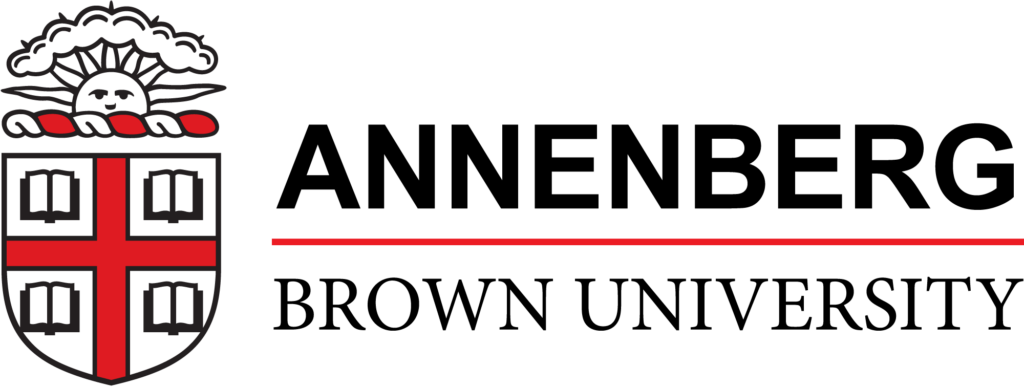

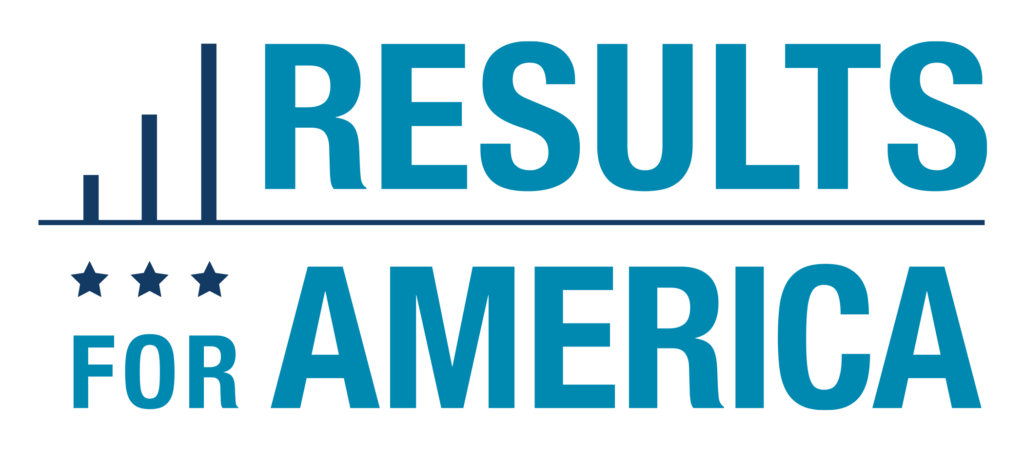
Funding for this research was provided by the Bill & Melinda Gates Foundation. The findings and conclusions contained within are those of the authors and do not necessarily reflect positions or policies of the foundation.

